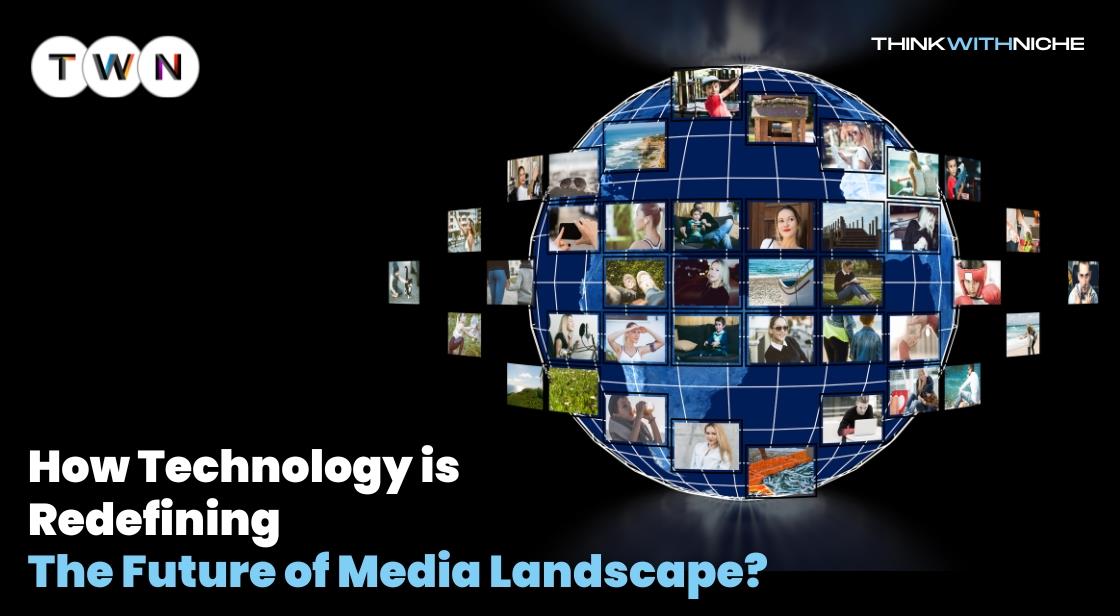How Technology is Redefining the Future of Media Landscape?

Blog Post
In an era where digital evolution is the driving force behind most industries, the media landscape stands at the forefront of this technological revolution. Welcome to "How Technology is Redefining the Future of Media Landscape."
In this forward-looking exploration, we delve into the fascinating interplay between technology and the ever-evolving world of media.
The digital age has ushered in a profound transformation in the way we create, consume, and interact with media. From the traditional confines of newspapers and scheduled television programming, we've entered an era where technology is the linchpin that shapes every facet of media.
This article ventures into the heart of this transformation, unveiling the latest trends, the associated challenges, and the incredible opportunities that technology has unfurled in the world of media.
Join us on this journey as we dissect how technology is redefining the future of media landscape, exploring the digital evolution, the impact of technology, and the vast canvas of possibilities it has painted for the future of media.
The digital era is here, and it's rewriting the script for media in ways we could have scarcely imagined.
The media landscape is undergoing a profound transformation, and at the heart of this evolution lies technology. From the way news is reported to how entertainment is consumed, technology is redefining every aspect of media.
Technology is transforming every sector of the economy, and the media industry is no exception. From the rise of streaming services to the growing popularity of social media, technology is changing the way we consume and create media.
In this blog post, we will explore some of the key technological trends that are redefining the future of the media landscape. We will also discuss the challenges and opportunities that these trends present.
How Technology is Redefining the Future of Media Landscape
The Digital Media Transformation
The media landscape has experienced a radical shift with the advent of digital technology. Traditional print media is making way for online publications, and television is transitioning into streaming platforms. Here are key aspects of this digital transformation:
-
On-demand content: Digital media has made it possible for consumers to access content on-demand, whenever and wherever they want. This has led to the decline of traditional scheduled programming.
-
Personalization: Digital media platforms can collect data about their users' preferences to personalize their content offerings. This has led to a more fragmented media landscape, with consumers consuming content from a variety of sources.
-
User-generated content: Digital media platforms have made it easy for users to create and share their own content. This has led to the rise of new forms of media, such as social media, blogs, and vlogs.
-
Interactivity: Digital media platforms allow users to interact with content in new ways. For example, users can comment on articles, like videos, and share content on social media.
Content Consumption in the Digital Age
Consumers are no longer bound by scheduled programming or print deadlines. Technology has ushered in an era of on-demand content consumption. Streaming services, podcasts, and digital publications have given audiences the freedom to choose what, when, and how they consume media.
This shift has had a profound impact on the media landscape. Content creators now have more opportunities to reach their audiences, and consumers have more choice and control over what they watch, listen to, and read.
Latest examples and facts about content consumption in the digital age:
-
Streaming services are the most popular way to watch TV and movies. In 2023, streaming services accounted for over 50% of all TV viewing in the United States.
-
Podcasts are becoming increasingly popular. In 2022, there were over 2 million podcasts available, and the average American listened to 7 podcasts per month.
-
Digital publications are growing in popularity. In 2023, digital subscriptions to newspapers and magazines exceeded print subscriptions for the first time.
-
Consumers are consuming more content on mobile devices. In 2022, 87% of Americans used their smartphones or tablets to access the internet.
The digital age has also led to the rise of new types of content, such as user-generated content (UGC) and influencer marketing. UGC is content that is created by users, such as social media posts, blog posts, and YouTube videos.Influencer marketing is a marketing strategy that entails collaborating with individuals who possess a substantial and engaged audience on various social media and online platforms.
These trends are having a significant impact on the way that businesses and organizations communicate with their audiences. Businesses and organizations now need to create content that is engaging, informative, and accessible on a variety of devices.
Content consumption in the digital age is constantly evolving. Businesses and organizations need to stay up-to-date on the latest trends and technologies in order to reach their audiences effectively.
Rise of Citizen Journalism
Technology has empowered ordinary citizens to become reporters and broadcasters. Social media platforms allow anyone with a smartphone to capture and share news as it happens. This shift has implications for traditional journalism, with both opportunities and challenges arising from this democratization of news.
Examples of Citizen Journalism
Here are some examples of citizen journalism in action:
-
The Arab Spring: Citizen journalists played a vital role in reporting on the uprisings that swept across the Arab world in 2011. They used social media to share videos and photos of the protests, which helped to raise awareness of the movement and put pressure on authoritarian regimes.
-
The Ferguson unrest: In 2014, citizen journalists played a key role in reporting on the protests that erupted in Ferguson, Missouri, following the police shooting of Michael Brown. They used social media to share videos and photos of the protests, which helped to document police brutality and sparked a national conversation about race and policing.
-
The Black Lives Matter movement: Citizen journalists have continued to play an important role in reporting on the Black Lives Matter movement. They have used social media to share videos and photos of police brutality and protests, which has helped to raise awareness of the movement's demands.
Opportunities and Challenges of Citizen Journalism
The rise of citizen journalism presents a number of opportunities for traditional journalism. Citizen journalists can provide real-time coverage of events that are happening in remote or dangerous locations. They can also provide insights into local communities and perspectives that traditional journalists may not have access to.
However, the rise of citizen journalism also presents a number of challenges for traditional journalism. Citizen journalists may not have the same level of training or experience as traditional journalists. This can lead to inaccurate or misleading reporting. Additionally, the spread of misinformation and disinformation on social media can make it difficult for consumers to discern between credible and non-credible sources of news.
Future of Citizen Journalism
The future of citizen journalism is uncertain. However, it is clear that citizen journalists will continue to play an important role in the media landscape. Traditional journalism organizations need to find ways to collaborate with citizen journalists and to verify their reporting. They also need to develop new ways to engage with audiences who are increasingly consuming news on social media.
Here are some potential future trends in citizen journalism:
-
Increased use of AI: Citizen journalists will increasingly use AI-powered tools to automate tasks such as fact-checking and video editing. This will allow them to produce more high-quality content and to reach a wider audience.
-
Greater collaboration with traditional media: Citizen journalists will collaborate more closely with traditional media organizations. This will allow them to share their reporting with a wider audience and to benefit from the expertise of traditional journalists.
-
New forms of storytelling: Citizen journalists will use new technologies such as VR and AR to create immersive storytelling experiences. This will allow audiences to feel like they are part of the news stories they are consuming.
The rise of citizen journalism is a complex and evolving phenomenon. It is important to be aware of both the opportunities and challenges that it presents. By working together, citizen journalists and traditional journalists can create a more informed and engaged public.
The Rise of Streaming Services
Streaming services have brought about a significant transformation in how we engage with media content. They have made it easier, more convenient, and more affordable to watch our favorite shows and movies. As a result, streaming services have become increasingly popular, and cable TV subscriptions have declined significantly.
In addition to the major streaming services mentioned above, there are now a number of other streaming services available, including Hulu, Apple TV+, HBO Max, and Paramount+. These services offer a wide variety of content, including original shows and movies, licensed content from other companies, and live TV streaming.
The rise of streaming services has had a number of positive impacts on the media industry. It has made it easier for content creators to reach a global audience, and it has given consumers more choice and control over what they watch. Streaming services have also led to a more diverse and inclusive media landscape, with more programming from different backgrounds and perspectives.
However, there are also some challenges associated with the rise of streaming services. One challenge is the increasing competition between streaming services, which can lead to higher prices for consumers. Another challenge is the fragmentation of the media landscape, with different streaming services offering different content.
This can make it difficult for consumers to find the content they want to watch, and it can also make it difficult for advertisers to reach their target audiences.
Overall, the rise of streaming services has been a positive development for the media industry and for consumers. However, there are some challenges that need to be addressed, such as the increasing competition between streaming services and the fragmentation of the media landscape.
Latest Facts on the Rise of Streaming Services
-
The global streaming video market is expected to reach $250 billion by 2025.
-
Streaming services now account for over 50% of all TV viewing in the United States.
-
Netflix is the most popular streaming service in the world, with over 220 million subscribers.
-
Disney+ is the fastest-growing streaming service in the world, with over 150 million subscribers in just two years.
-
Streaming services are increasingly investing in original content. In 2022, Netflix spent over $17 billion on original content, and Disney+ spent over $11 billion on original content.
-
Streaming services are also expanding into new markets. For example, Disney+ launched in India in 2023 and has already become one of the most popular streaming services in the country.
The rise of streaming services is a major trend that is transforming the media industry. Streaming services are changing the way we consume media, and they are also changing the way that content is created and distributed.
Also Read: All Times Best Marketing Campaigns
The Growth of Social Media
Social media platforms have firmly entrenched themselves in our daily existence. They allow us to stay connected with friends and family, discover new content, and learn about the world around us. Social media platforms have also become essential tools for businesses and organizations to reach their target audiences.
A few of the widely used social media platforms encompass Facebook, Twitter, Instagram, TikTok, and YouTube. These platforms boast an array of functionalities, including:
-
The ability to share text, photos, and videos
-
The ability to connect with friends and family
-
The ability to follow businesses, organizations, and public figures
-
The ability to discover new content
-
The ability to join groups and communities
Social media platforms have had a number of positive impacts on society. They have made it easier for people to stay connected with friends and family, regardless of distance. Social media platforms have also made it easier for people to discover new content and learn about the world around them. Additionally, social media platforms have played a major role in the rise of citizen journalism, giving people a platform to share news and information from all over the world.
However, there are also some challenges associated with social media platforms.An issue lies in the dissemination of misinformation and disinformation. Social media platforms can be used to spread false or misleading information, which can have a negative impact on society. Additionally, social media platforms can be used to promote hate speech and extremism.
Another challenge is the issue of privacy. Social media platforms collect a lot of data about their users, and there is a concern that this data could be used for malicious purposes. Additionally, social media platforms can be addictive, and there is a concern that they can have a negative impact on mental health.
Overall, social media platforms have had a mixed impact on society. They have made it easier for people to stay connected, discover new content, and learn about the world around them.
However, there are also some challenges associated with social media platforms, such as the spread of misinformation and disinformation, privacy concerns, and addiction.
Latest updates on Growth of Social Media
-
The global social media market is expected to reach $215 billion by 2025.
-
There are now over 4.6 billion social media users worldwide.
-
TikTok has emerged as the world's most rapidly expanding social media platform, boasting an active user base exceeding 1 billion.
-
Social media platforms are increasingly investing in video content. In 2022, YouTube paid over $30 billion to creators, and TikTok paid over $10 billion to creators.
-
Social media platforms are also venturing into emerging markets.For example, TikTok launched in India in 2022 and has already become one of the most popular social media platforms in the country.
The growth of social media is a major trend that is transforming the way we communicate and interact with each other. Social media platforms are changing the way we consume news, entertainment, and other forms of content. They are also changing the way we do business and the way we organize ourselves politically.
Social media platforms have the potential to make the world a better place by connecting people and giving them a platform to share their voices. However, it is important to be aware of the challenges associated with social media platforms, such as the spread of misinformation and disinformation, privacy concerns, and addiction. By being aware of these challenges, we can take steps to mitigate them and ensure that social media platforms are used for good.
The Emergence of New Media Formats
New media formats such as virtual reality (VR) and augmented reality (AR) are emerging and have the potential to revolutionize the way we consume and create media.
Virtual Reality
Virtual reality (VR) offers a simulated experience that may closely resemble or differ entirely from the physical world. VR is created using computer-generated imagery (CGI) and other technologies to create an immersive experience for the user.
VR headsets are used to access VR experiences. VR headsets typically have two lenses, one for each eye, which create the illusion of depth. VR headsets also have sensors that track the user's head movements, so that the VR experience can adjust accordingly.
VR is being used in a variety of industries, including gaming, entertainment, education, and healthcare.
Some examples of VR in different industries:
-
Gaming: VR is employed to craft immersive gaming encounters. For example, the VR game Beat Saber allows players to slice blocks of music with lightsabers.
-
Entertainment: VR is being utilized to generate immersive entertainment moments. For example, the VR movie Avengers: Endgame allows viewers to experience the Battle of Earth from the perspective of different characters.
-
Education: VR is employed for crafting immersive educational encounters. For example, the VR app Google Earth VR allows users to explore the world in 3D.
-
Healthcare: VR is being used to treat pain, anxiety, and other conditions. For example, the VR app Pain Ease VR is used to help patients with chronic pain manage their pain.
Augmented Reality
Augmented reality (AR) is a technology that superimposes digital information onto the physical world. AR is created using computer vision and other technologies to track the real world and place digital objects within it.
AR is being used in a variety of industries, including gaming, entertainment, education, and retail.
Examples of AR in different industries:
-
Gaming: AR is being used to create immersive gaming experiences. For example, the AR game Pokémon GO allows players to catch and battle Pokémon in the real world.
-
Entertainment: AR is being used to create immersive entertainment experiences. For example, the AR app Snapchat allows users to add filters and effects to their selfies.
-
In the realm of education, AR is employed to craft immersive educational encounters. For example, the AR app Quiver allows users to color in 2D images and then watch them come to life in AR.
-
Retail: AR is being used to help customers visualize products in their homes. For example, the AR app IKEA Place allows users to place virtual furniture in their homes to see how it would look.
The Future of New Media Formats
New media formats such as VR and AR have the potential to revolutionize the way we consume and create media. VR and AR can be used to create immersive and interactive experiences that are not possible with traditional media formats.
As the technology continues to develop and become more affordable, VR and AR are expected to become more mainstream and widely used in a variety of industries.
The Importance of Data and Analytics
In the media sector, the significance of data and analytics is steadily on the rise. Media companies are using data and analytics to understand their audiences, improve their content, and measure the effectiveness of their marketing campaigns.
Examples of How Media Companies Are Using Data and Analytics
Here are some examples of how media companies are using data and analytics:
-
Netflix: Netflix uses data and analytics to recommend content to its users. Netflix also uses data and analytics to decide which shows to cancel and renew.
-
Spotify: Spotify uses data and analytics to recommend music to its users. Spotify also uses data and analytics to create playlists and to discover new artists.
-
The New York Times: The New York Times uses data and analytics to understand its readership and to improve its content. The New York Times also uses data and analytics to target advertising.
Benefits of Using Data and Analytics
There are a number of benefits to using data and analytics in the media industry. Data and analytics can help media companies to:
-
Understand their audiences: Data and analytics can help media companies to understand their audiences' demographics, interests, and behaviors. This data can be utilized to generate content that is both more pertinent and captivating.
-
Improve their content: Data and analytics can help media companies to track how users interact with their content and to identify areas for improvement. For example, media companies can use data and analytics to see which types of content are most popular, which parts of their content are most engaging, and which parts of their content are leading to users dropping off.
-
Measure the effectiveness of their marketing campaigns: Data and analytics can help media companies to measure the effectiveness of their marketing campaigns. This information can be used to improve their campaigns and to allocate resources more efficiently.
Future of Data and Analytics in the Media Industry
The use of data and analytics in the media industry is expected to continue to grow in the future. Media companies will invest more in data and analytics technology and in hiring data scientists and analysts.
Here are some potential future trends in the use of data and analytics in the media industry:
-
AI-powered personalization: Media companies will use AI to personalize content and recommendations for individual users.
-
Predictive analytics: Media companies will use predictive analytics to forecast future trends and to make better decisions about content production and marketing.
-
Data-driven decision making: Media companies will make more decisions about content production, marketing, and other business operations based on data and analytics.
The use of data and analytics is essential for media companies to succeed in the digital age. By using data and analytics, media companies can understand their audiences, improve their content, and measure the effectiveness of their marketing campaigns.
The Challenge of Disinformation
The spread of misinformation is a major challenge facing the media industry today. Misinformation is false or misleading information that is spread, regardless of whether there is intent to deceive.
Misinformation can be spread through social media, online news websites, and other online platforms. It can also be spread through traditional media outlets, such as newspapers and television.
Misinformation can have a negative impact on society, leading to confusion, division, and violence. Media companies have a responsibility to combat the spread of misinformation and to provide accurate and reliable information to their audiences.
The Future of Media
The future of media is bright, with technology creating new opportunities for content creators, consumers, and businesses alike.
However, there are also challenges that need to be addressed, such as the spread of misinformation. Media companies will need to adapt to the changing media landscape and find new ways to reach and engage their audiences.
Conclusion
Technology is rapidly redefining the future of the media landscape, creating new opportunities and challenges for content creators, consumers, and businesses alike. Media companies that are able to adapt to the changing landscape and embrace new technologies will be well-positioned to succeed in the future.
You May Like
EDITOR’S CHOICE












